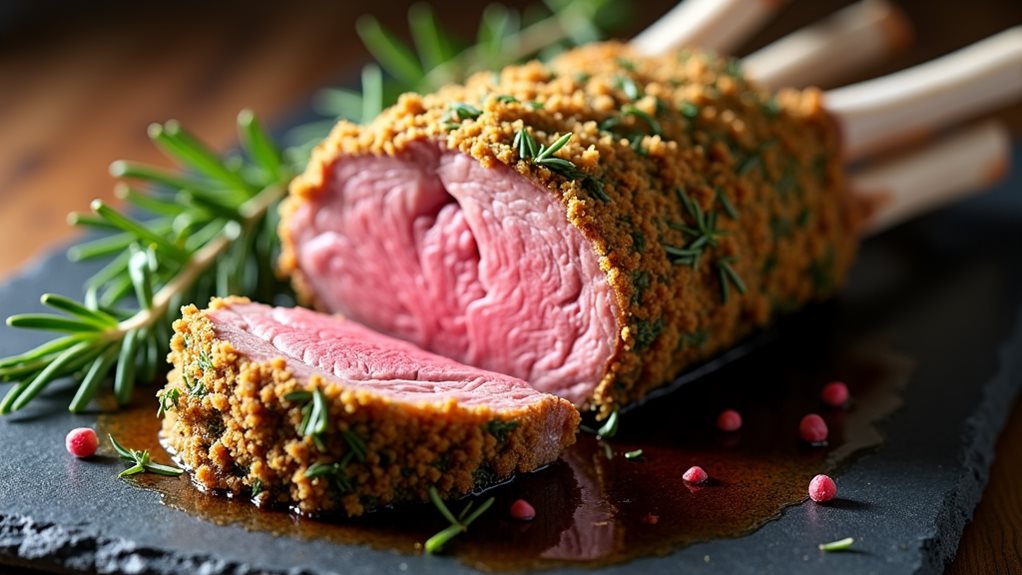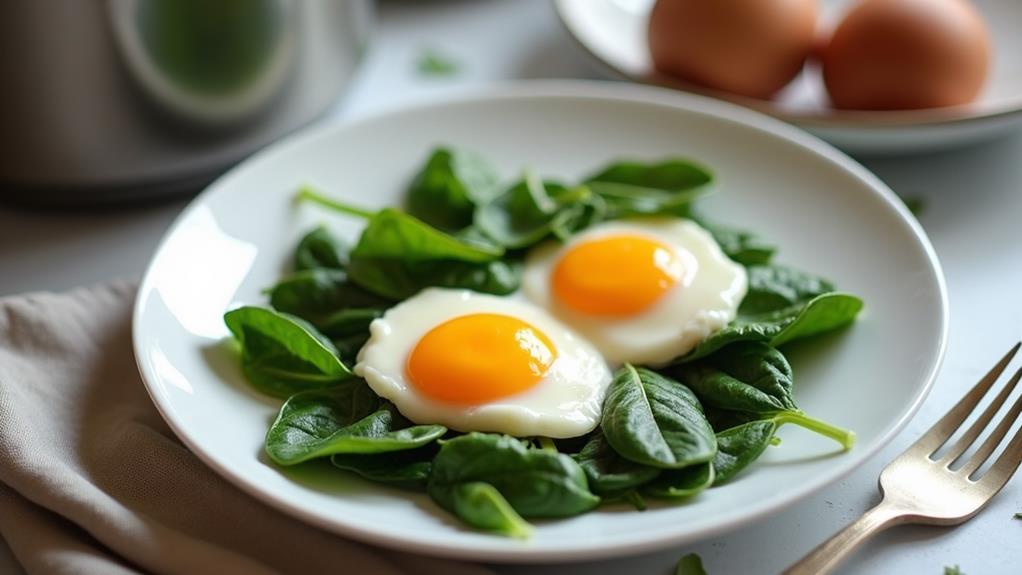When you're ready to elevate your culinary skills, a perfectly executed herb-crusted rack of lamb with rosemary jus will showcase your mastery in the kitchen. This classic French-inspired dish combines the rich, tender meat of premium lamb with an aromatic herb crust and savory pan sauce. While it may seem intimidating at first, you'll discover that creating this restaurant-worthy centerpiece requires just a few key techniques and careful attention to timing. Let's explore how you can master this impressive dish.
Key Takeaways
- Sear the lamb rack in a hot skillet until golden-brown, then coat generously with Dijon mustard before applying the herb crust.
- Create a crust by combining fresh rosemary, seasoned breadcrumbs, salt, and pepper, binding with olive oil for even distribution.
- Roast at 375°F for 20-25 minutes until internal temperature reaches 135°F, monitoring to prevent over-browning of the crust.
- Allow lamb to rest for 10 minutes under loose foil before slicing to ensure optimal moisture retention and flavor distribution.
- Serve with rosemary jus, made from pan drippings, red wine, and fresh rosemary for an elegant sauce complement.
History
While the exact origins of herb-crusted rack of lamb remain somewhat unclear, this elegant preparation method can be traced back to classical French cuisine of the 17th century, when master chefs began developing sophisticated techniques to enhance the natural flavors of premium cuts.
You'll find that the herb crust tradition evolved from the medieval practice of using breadcrumbs and aromatics to preserve meat, eventually transforming into a refined culinary technique.
By the 19th century, herb-crusted lamb had become a staple in high-end European restaurants, where chefs perfected the delicate balance between the crispy exterior and tender meat.
Today's version, combining Dijon mustard with fresh herbs and breadcrumbs, represents centuries of culinary refinement and remains a testament to French cooking's enduring influence.
Recipe
A perfectly cooked rack of lamb is one of the most elegant dishes you can serve, combining the rich, succulent flavor of premium lamb with a crispy, aromatic herb crust. When prepared correctly, this dish creates a stunning presentation that's sure to impress any dinner guest, making it ideal for special occasions or sophisticated dinner parties.
The secret to this recipe lies in the careful balance of flavors and textures. The herb crust provides a delightful crunch while protecting the tender meat beneath, and the Dijon mustard adds a subtle tang that enhances both the lamb and the herbs. When sliced, each chop should reveal a perfectly pink center surrounded by the golden-brown crust.
- 2 racks of lamb (1.5-2 lbs each/700-900g each), frenched
- 1/2 cup (15g) fresh rosemary, finely chopped
- 3 tablespoons (45ml) Dijon mustard
- 1 cup (120g) breadcrumbs
- 1/4 cup (60ml) olive oil
- Salt and black pepper to taste
Preheat oven to 375°F (190°C). Pat the lamb racks dry with paper towels and season generously with salt and pepper. Heat olive oil in a large skillet over medium-high heat and sear the lamb on all sides until golden brown, about 2-3 minutes per side. Remove from heat and brush each rack thoroughly with Dijon mustard.
In a bowl, combine the chopped rosemary with breadcrumbs, then press this mixture firmly onto the mustard-coated lamb. Place the racks in a roasting pan and cook for 20-25 minutes for medium-rare, or until internal temperature reaches 135°F (57°C). Allow to rest for 10 minutes before slicing between the bones.
For the best results, remove the lamb from the refrigerator 30-60 minutes before cooking to ensure even cooking. The herb crust should be pressed firmly onto the mustard to prevent it from falling off during cooking. If the crust starts to brown too quickly, tent the lamb with foil.
Always use a meat thermometer to ensure proper doneness, and remember that the internal temperature will rise about 5 degrees during the resting period. For a more dramatic presentation, wrap the exposed bones in foil before cooking to prevent them from burning.
Cooking Steps
You'll want to start by searing your lamb racks in a hot skillet until they're golden brown on all sides, creating a flavorful crust that seals in the juices.
Next, brush the seared lamb generously with Dijon mustard before pressing on your rosemary-breadcrumb mixture, ensuring it adheres evenly to form a uniform crust.
Finally, roast the lamb at 375°F until it reaches your desired doneness, letting it rest for 10 minutes before slicing to ensure the juices redistribute throughout the meat.
Step 1. Sear Lamb Until Golden
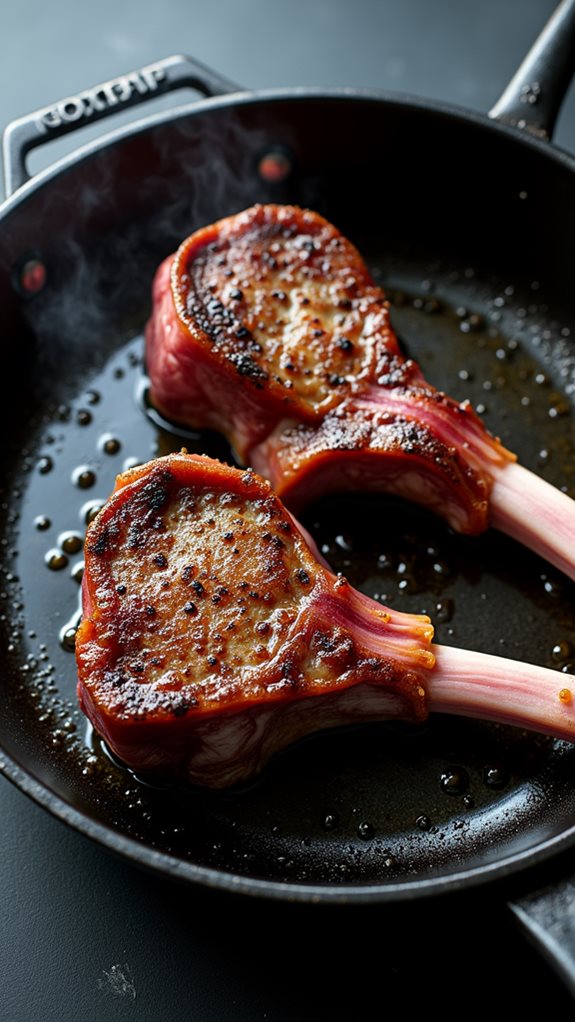
Begin by heating a large skillet or heavy-bottomed pan over medium-high heat until it's properly hot, as achieving the right temperature ensures a perfect golden crust on the lamb.
Add your olive oil to the pan, and once it begins to shimmer, carefully place your seasoned rack of lamb in the skillet.
You'll want to sear each side for about 2-3 minutes, using tongs to rotate the rack until all surfaces develop a rich, golden-brown color.
Don't forget to sear the ends as well.
As you're searing, resist the urge to move the meat too frequently – giving each side enough time to develop that beautiful crust is crucial.
Once you've achieved an even golden color, remove the rack from the heat.
Step 2. Coat Lamb With Mustard
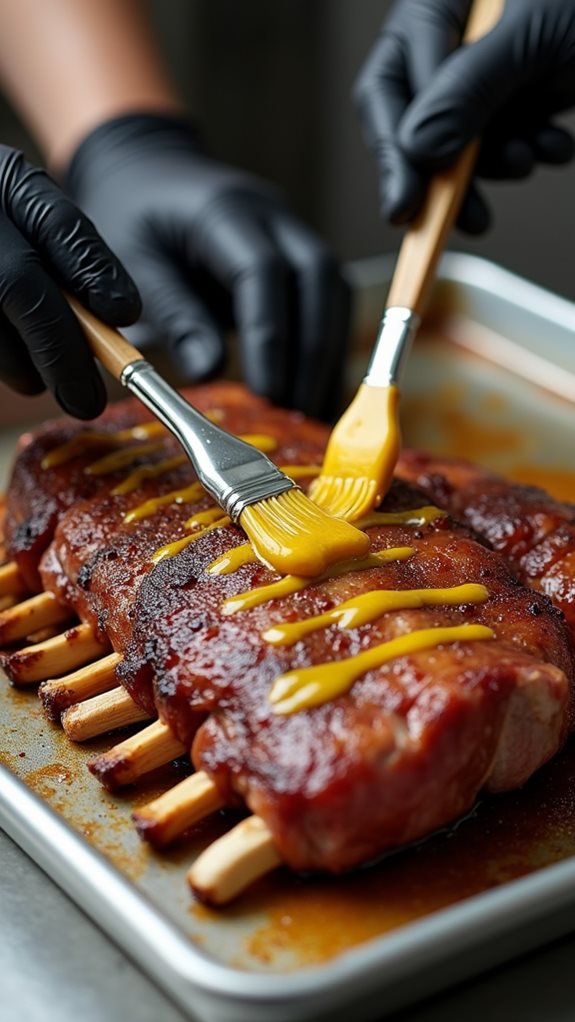
With the seared lamb now exhibiting a perfect golden crust, the next step introduces a key flavor-building component that acts as both seasoning and adhesive.
You'll need to brush a generous layer of Dijon mustard over the entire surface of each rack, making sure to coat all exposed areas of meat while avoiding the bones.
The mustard's tangy profile won't dominate the final dish, but rather, it'll create a subtle depth that complements the lamb's natural flavor.
More importantly, it serves as the essential binding agent that'll help your herb crust adhere properly during cooking.
Work quickly while the lamb is still warm, as this will help the mustard spread more evenly and create the ideal surface for the upcoming breadcrumb mixture.
Step 3. Create Rosemary-Breadcrumb Mixture

Prepare the aromatic herb crust by combining finely chopped fresh rosemary and seasoned breadcrumbs in a medium mixing bowl.
Add a pinch of salt and freshly ground black pepper to enhance the mixture's savory profile, then drizzle with a small amount of olive oil to help bind the ingredients together.
Using your fingertips, gently work the oil through the breadcrumbs until they're evenly moistened but still loose and crumbly.
You'll want to ensure the rosemary is chopped very finely to distribute its intense flavor throughout the crust and prevent any large pieces from becoming bitter during cooking.
If you're using dried breadcrumbs, you might need slightly more olive oil to achieve the right consistency, while fresh breadcrumbs will require less.
Step 4. Roast at Correct Temperature
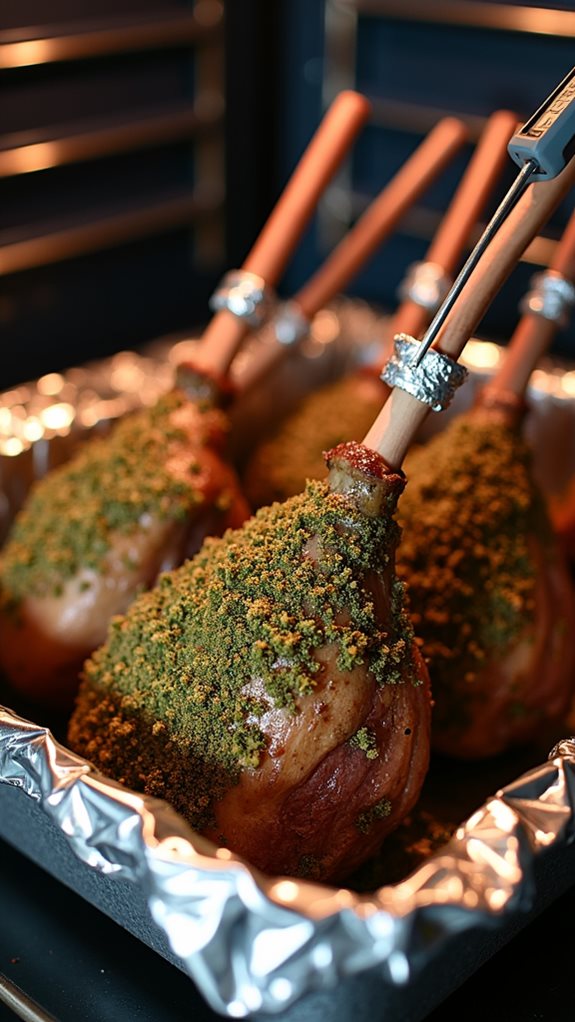
Placing your herb-crusted rack of lamb in a preheated 375°F (190°C) oven marks the crucial final phase of cooking this elegant dish.
You'll want to roast the lamb for 20-25 minutes to achieve a perfect medium-rare, checking that the internal temperature reaches 135°F (57°C) using a meat thermometer.
If you notice the herb crust browning too quickly during cooking, don't panic – simply cover the rack loosely with aluminum foil to prevent burning while the meat continues to cook.
Keep a close eye on the temperature, as overcooking can quickly turn your perfectly tender lamb tough and dry.
Once you've reached the desired temperature, remove the rack from the oven and let it rest for 10 minutes before slicing to ensure the juices redistribute properly.
Step 5. Rest Before Serving
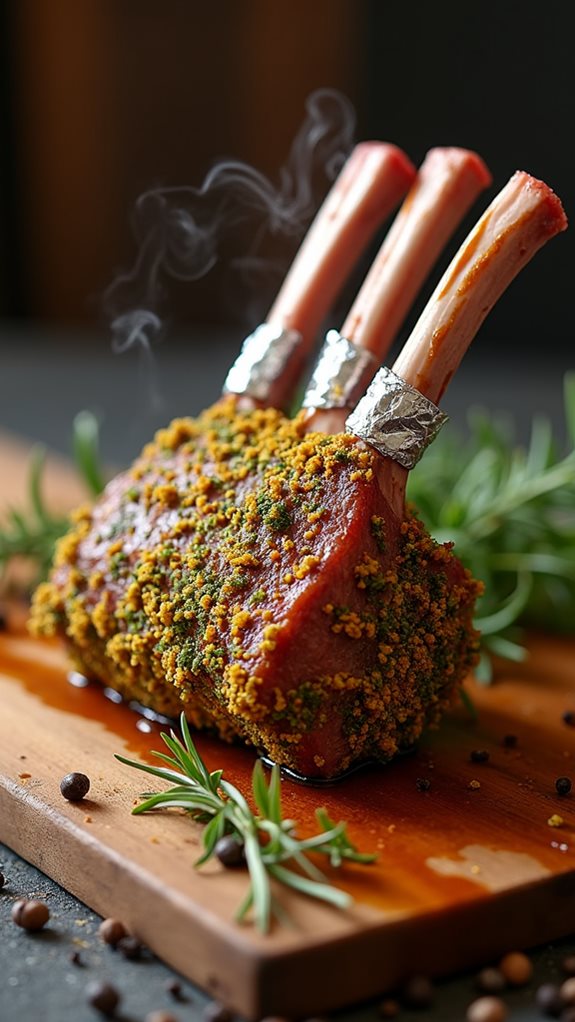
After removing your perfectly roasted rack of lamb from the oven, you'll need to let it rest for 10 minutes before slicing, which allows the meat's internal juices to redistribute evenly throughout.
During this crucial resting period, don't cover the lamb too tightly, as this can cause the herb crust to become soggy from trapped steam. Instead, tent it loosely with foil to maintain warmth while allowing excess moisture to escape.
You'll know the lamb has rested properly when it feels slightly firmer to the touch and doesn't release excessive juices when cut.
If you slice too soon, you'll lose those precious juices onto the cutting board rather than enjoying them in each bite, resulting in drier meat.
Final Thoughts
This herb-crusted rack of lamb delivers the perfect balance of elegant presentation and rich flavor, making it an ideal choice for special occasions or when you're looking to elevate your culinary repertoire.
While the dish may seem intimidating at first, you'll find that breaking it down into manageable steps makes it surprisingly approachable.
Remember that success lies in the details: ensuring your meat comes to room temperature, achieving a proper sear, and allowing adequate resting time.
Don't rush the process, as each step contributes to the final result.
With practice, you'll master the timing and techniques needed to consistently produce a perfectly crusted, juicy rack of lamb that's sure to impress your guests.

